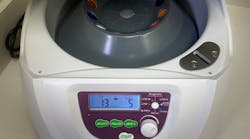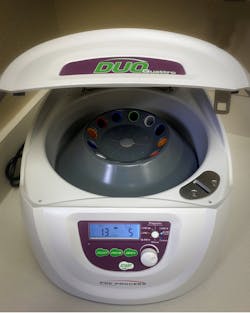Autologous platelet-rich fibrin: Use in prevention and treatment of dry socket
Localized alveolar osteitis (dry socket) is one of the most vexing problems following tooth extraction for both patient and doctor. The incidence of dry socket has been estimated be as high as 20% in the average patient population and even greater in high-risk groups, including patients with significant smoking history or healing disorders.
A broad range of management options for localized osteitis have been tried over the years. The most popular is the use of medicated dressings with some form of eugenol product. The dilemma with all forms of medicated dressings is that we are managing the problem after the fact. Wouldn’t it be nice to have an option to preventively intervene in this situation? The answer lies in the use of autologous platelet-rich fibrin (PRF).
Benefits of platelet-rich fibrin
The wound-healing power of platelet concentrates has been used in oral surgery since 19971 with the introduction of platelet-rich plasma (PRP). The equipment and supplies necessary for this technique limited its practicality to larger oral surgery cases. But with the advent of PRF and the associated reduction in armamentarium, this technique has become widely available and useful, even for minor oral surgical procedures such as tooth extraction.
Related articles:
- Alveolar osteitis: Etiology, prevention, and treatment
- Dry socket treatment and prevention: What to tell your patients
The PRF technique has a host of literature supporting its use and has been shown to reduce postoperative pain and swelling, decrease healing times, and significantly decrease the incidence and severity of dry socket.2,3 PRF can be utilized at the time of tooth extraction and as a treatment for established dry socket. Most of the benefit seems to be in augmenting soft-tissue healing.4,5
PRF technique
The PRF technique is easily mastered and involves venipuncture and a blood draw utilizing easily available equipment and supplies. Patients are familiar with the technique since it is exactly what they experience for routine medical lab tests. A centrifuge capable of separating the blood into its components is integral to the outcome, with technique-specific centrifuges commercially available. While the specifics of the technique are beyond the scope of this article, they involve relatively quick and simple steps.Once the blood has been centrifuged, the PRF plug is removed carefully and inserted into the surgical site. This technique harnesses the body’s own bioactive processes to aide in wound healing and is well within the scope of general practice. This technique has applications for both oral surgical and periodontal procedures. An excellent review of the literature regarding PRF application can be found in the articles referenced here.6,7
Dental insurance reimbursement
Insurance reimbursement may be available utilizing CPT code 7921—Collection and application of autologous blood concentrate product. Regardless, the cost is minimal for the patient, especially considering reduced lost time from work, fewer trips to the office for dressing changes, and less pain and aggravation.
The next time you treat a patient for dry socket, ask yourself: Is this someone who could have benefited from PRF? I believe you will find the answer to be a resounding yes!
Disclosure: Dr. Stewart has no financial relationship with products mentioned or displayed. These products are used in the regular course of practice.
Editor’s note: This article first appeared in Through the Loupes newsletter, a publication of the Endeavor Business Media Dental Group. Read more articles and subscribe to Through the Loupes
References
- Whitman DH, Berry RL, Green DM. Platelet gel: an autologous alternative to fibrin glue with applications in oral and maxillofacial surgery. J Oral Maxillofac Surg. 1997;55(11):1294-1299. doi:10.1016/s0278-2391(97)90187-7
- Borie E, Olivi DG, Orsi IA, et al. Platelet-rich fibrin application in dentistry: a literature review. Int J Clin Exp Med. 2015;8(5):7922-7929.
- Daugela P, Grimuta V, Sakavicius D, Jonaitis J, Juodzbalys G. Influence of leukocyte- and platelet-rich fibrin (L-PRF) on the outcomes of impacted mandibular third molar removal surgery: a split-mouth randomized clinical trial. Quintessence Int. 2018;49(5):377-388. doi:10.3290/j.qi.a40113
- Eshghpour M, Dastmalchi P, Nekooei AH, Nejat AH. The effect of platelet-rich fibrin on frequency of alveolar osteitis following mandibular third molar surgery: a double-blinded randomized clinical trial. J Oral Maxillofac Surg. 2014;72(8):1463-1467. doi:10.1016/j.joms.2014.03.029
- Makki AZ, Alsulami AM, Almatrafi AS, Sindi MZ, Sembawa SN. The effectiveness of advanced platelet-rich fibrin in comparison with leukocyte-platelet-rich fibrin on outcome after dentoalveolar surgery. Int J Dent. 2021;2021:6686857. doi:10.1155/2021/6686857
- Miron RJ, Zuccelli G, Pikos MA, et al. Use of platelet-rich fibrin in regenerative dentistry: a systematic review. Clin Oral Investig. 2017;21(6):1913-1927. doi:10.1007/s00784-017-2133-z
- Borie E, Olivi DG, Orsi IA, et al. Platelet-rich fibrin application in dentistry: a literature review. Int J Clin Exp Med. 2015;8(5):7922-7929.








